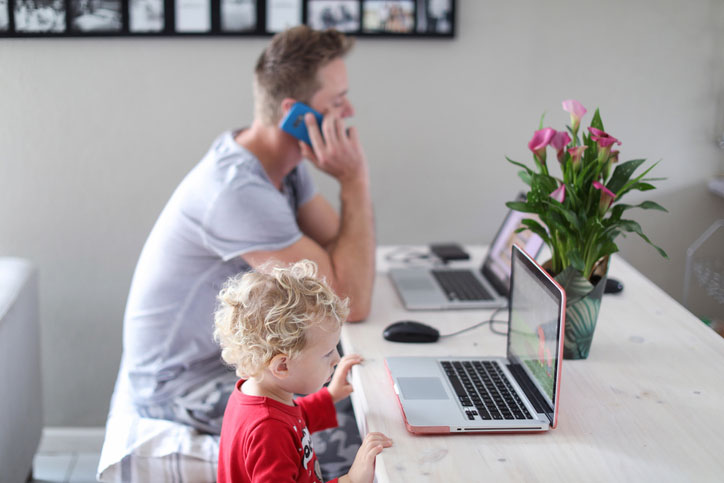
Reviewed by Mary McLaughlin, M.S. SpEd; Ma-TESOL
Answers to the Big Questions About Childcare Options, Working from Home, and At-Home ECE During the COVID-19 Pandemic
As any parent will attest, life with a preschooler can be rather unpredictable. On any given day, you may be met with a cuddly love bug who craves your full attention …an unreasonable little dictator who demands another cookie (or two or three) …or a rambunctious ball of energy who doesn’t seem at all tired, despite it being an hour past bedtime.
But COVID-19 ushered in a new type of unpredictable—and with it questions and concerns about the care of your favorite little one.
The shutdown of schools and businesses has left many parents scrambling for emergency childcare or at-home learning ideas when preschool doors are no longer open. It’s also left many wondering whether it’s still safe to drop off their toddler at daycare when work obligations call.
We have the answers to your most pressing questions about where and how to find daycare, what steps your childcare center is taking to stay safe during the pandemic, and how to develop a new at-home routine when preschool doors are shut. It’s an uncertain time, but we’re here to provide you with the concrete answers and the guidance you need to keep your child safe, healthy, and thriving.
My child’s daycare center is still open; is it safe to drop her off?
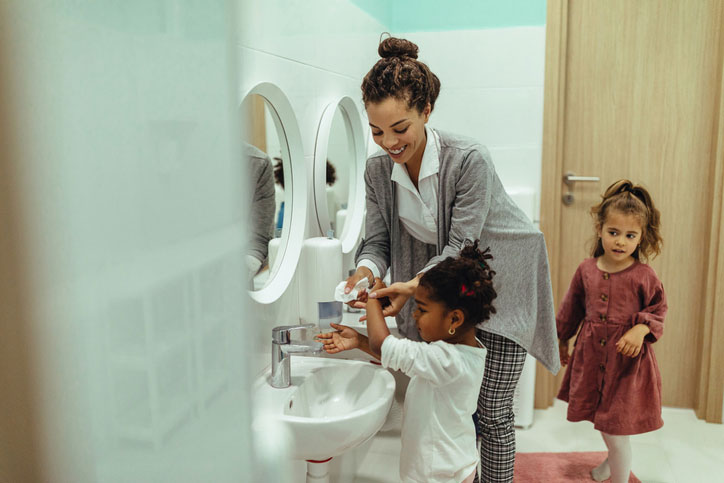
There’s no easy answer to this question. Ultimately, your decision to take your child to daycare (or keep her home) is a personal one that should be based on the unique needs of your family. If you are an essential worker, you may not feel that you have much choice in the matter so for you the questions come down to understanding the exact protocols that are in place to keep your child safe.
If you continue to use the services of a childcare provider (or are using childcare services for the first time), you’ll want to ask plenty of questions about what they’re doing to keep everyone safe and healthy during the pandemic.
One thing you can be sure of is that if they’re open, they are being held to requirements set forth by their local health departments and state childcare licensing board. You can view information regarding these requirements on your state health department or local health department website.
The Centers for Disease Control (CDC) also released a publication, Guidance for Childcare Programs That Remain Open, which provides a framework for childcare providers operating during the coronavirus. Some of the CDC’s recommendations include:
- Establishing a plan that protects staff, children, and their families from the spread of COVID-19
- Ensuring the center has an adequate supply of products that support routine cleaning and hand hygiene and intensifying cleaning and disinfecting strategies
- Modifying drop off and pickup procedures
- Implementing screening procedures upon arrival
- Establishing procedures to keep sick staff and children at home
- Implementing social distance strategies
Keep in mind that your state will determine whether childcare centers can remain open at all during the coronavirus pandemic and/or who can continue to provide services and to whom. About half of all states have closed childcare/daycare centers to everyone but essential workers, while the remaining states have permitted childcare centers to remain open during this time. You can check out state-by-state laws regarding childcare centers here.
I am an essential worker; where can I find emergency childcare?

In many areas, childcare centers are open only to essential workers; in other areas, temporary childcare centers have been opened to assist essential workers during the coronavirus.
Child Care Aware is an excellent resource for finding emergency childcare during this time. Click on your state on the U.S. map and you’ll be directed to a COVID-19 tab that includes an emergency childcare search and information regarding emergency childcare services where you live.
I’m having a hard time affording childcare right now. Is there assistance available?
The CARES Act, as part of the federal stimulus package used to combat the economic impact of COVID-19, includes $3.5 billion in discretionary funds that are distributed among the states. As part of the Act, these funds may be used to provide childcare assistance (without regard to income) to healthcare workers, emergency responders, sanitation workers, and others deemed essential during the coronavirus.
Childcare.gov provides a quick search tool that will direct you to information regarding financial assistance that may be available to you during this time.
Also, don’t hesitate to contact your childcare provider if you’re having difficulty paying your bill during the pandemic. Many providers across the country are working with families who are experiencing hardships by lowering tuition rates during this time.
Can my childcare provider still charge me tuition even when they’re closed or if I choose to keep my child at home during the pandemic?
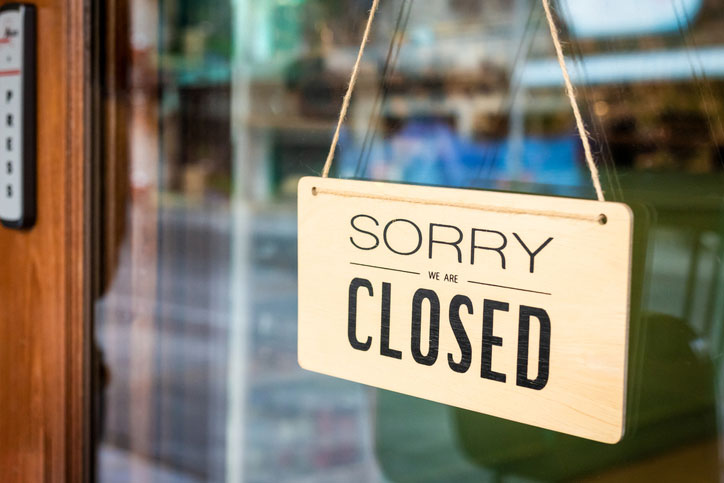
In many cases, yes. Check your childcare contract; many providers include a clause that requires clients to continue to pay, even when service is not provided due to a public health emergency. And if they remain open and you choose to keep your child at home, you’ll likely need to keep paying your contract.
You may also choose to continue paying out of a sense of moral obligation. Many childcare centers operate on razor-thin profit margins and losing even a small number of monthly tuition payments may mean staff layoffs or the closure of the center.
Is in-home childcare safer than center-based programs?
Many pediatricians have recommended in-home childcare (provided by one person) if keeping your child at home with a parent or guardian isn’t possible. At the same time, you’ll also need to weigh the risks and benefits of having a person come into your home to provide care, particularly if you have an elderly or immunocompromised family member at home.
In short, there’s no one right answer, so it’s up to you to consider what’s best for your family during this time.
How do I handle telecommuting with a young child at home?
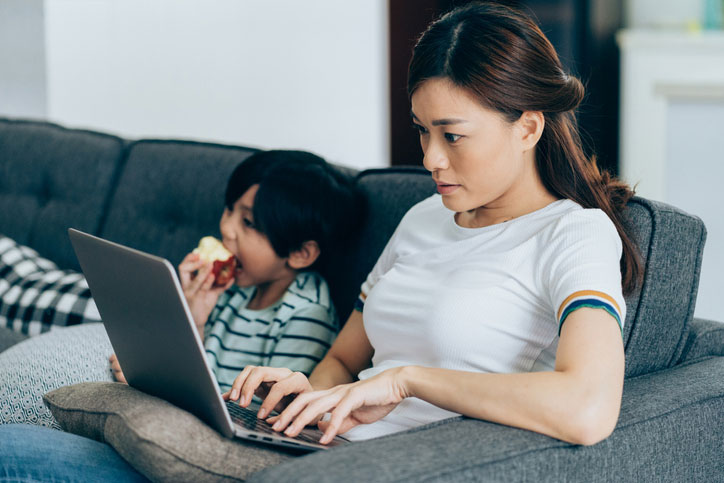
Millions of Americans across the country have been forced to take their work home because of COVID-19 stay-at-home orders. For working parents of small children, telecommuting comes with its share of significant challenges.
So, how can you continue to satisfy your work obligations while chasing around a lively two-year-old who requires round-the-clock attention and supervision?
If you can’t (or won’t) use childcare during this time, you’ll need to establish a schedule that works – and quick. Here are a few suggestions to make working at home and parenting more manageable:
- Talk to your employer about telecommuting requirements so it’s clear what is expected of you, and request flexibility in your hours, if possible. A non-traditional work schedule will likely be necessary if you must also handle parenting duties during the day. If you have a demanding little one at home, you may need the flexibility of putting in your work hours during the evening or during naptime. If you have a spouse or partner at home, arrange your schedules to give each other dedicated work hours each day.
- Save those phone calls/emails/conference calls that demand your full attention for naptime. If something requires your complete focus, chances are you won’t be able to give it the attention it deserves if you must also ensure your toddler isn’t in the next room looking for trouble.
- Understand that sticking to a strict work routine may not always work when it comes to living with a small child. For example, if it’s a nice day, take the opportunity to set work aside, even if it’s for 30 minutes, and get outside and run around with your preschooler. You’ll both benefit from this time spent together.
- If you must focus on work for a while, allow your child to pick a special toy, television show, or iPad game to keep them occupied. Keep your child in the same room (or adjoining room), so you can keep a close eye them while you tend to your work obligations. Reserve special toys or privileges for these times to keep your little one interested and engaged.
- Create a work schedule that includes breaks for quality time with your child. Blocks of quality parent-child time throughout the day are important for keeping small children happy, content, and entertained.
- Set up a simple system that lets your toddler know when it’s your time to work. You may tie a red ribbon to your office doorknob or set something on your desk to gently remind them that there’s work for you to do. Offer up plenty of praise when your child follows these visual cues during the day.
How do I develop a new at-home routine when preschool is closed?
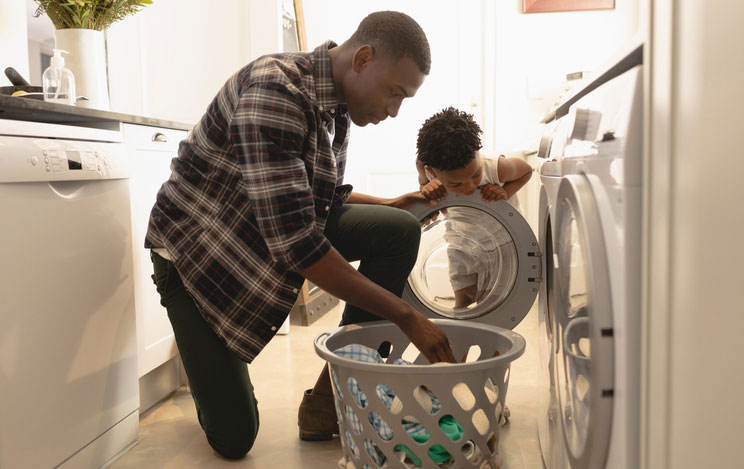
Just because your child’s early learning program is closed right now and you’re confined to the house doesn’t mean that fun and learning can’t continue. It’s important to keep your child safe, occupied, and stimulated during this time, and the easiest way to accomplish this is to create an at-home routine that works for both you and your child.
As you build your family routine, consider the following:
- Mirroring your child’s typical daycare/preschool schedule may be the ideal way to build your at-home schedule. A similar schedule eases the transition by providing your child with a predictable routine.
- Find opportunities to include your child in on your daily chores. Toddlers and preschoolers love being given tasks to complete that make them feel important and included. For example, give your child a boost at the sink so they can help wash off the vegetables for dinner, or ask them to match the socks by color as you fold laundry.
- Always save time for exercise. Whether you’re dancing to the radio or taking a walk around the neighborhood, it’s important to include opportunities for your child to burn energy and improve gross motor skills throughout the day. And exercise is great for your mind and body, too, especially during this time, so find opportunities to play with your little one and work up a sweat. Consider introducing your little one to yoga (We like YogiApproved’s guide to doing yoga with your toddler.) or going on a treasure hunt! (Parents.com has a great guide for preschool-friendly treasure hunts.)
- Break your day up into small blocks of time. Small children have difficulty paying attention for long periods of time, so it’s important to transition to a new activity every 15-30 minutes throughout the day.
- Don’t stress over more screen time. Allowing your preschooler to spend a little more time watching a developmentally appropriate television show or play games on trusted sites like PBSKids.org and Nick Jr. is okay during a time when you’re working from home or stuck in the house, provided it’s broken up with plenty of enrichment activities and exercise throughout the day.
- Ask your child’s preschool teacher for guidance on the curriculum, so you’ll have a framework for which skills to work on while preschool is closed. Education.com provides a nice selection of online games for preschoolers, along with printable worksheets and guided lessons for exciting learning opportunities.
There are a lot of uncertainties in the world right now, and with that comes a lot of unanswered questions – for both you and your kids. There is very little that any of us can do to change what’s going on in the world, but we can do our best to maintain a healthy, happy environment at home where our children can continue to learn and thrive. As anybody with a preschooler knows, even during the best of times keeping your day on track can be a challenge, and under the current circumstances, it can feel nearly impossible.
Even as we’re all stuck at home and dealing with the different ways the pandemic is affecting our lives individually, we can still be part of something positive in the world. Now is the time to rely on the resources available to you, and to share those resources with family and friends who could probably use a little extra help right now too.





